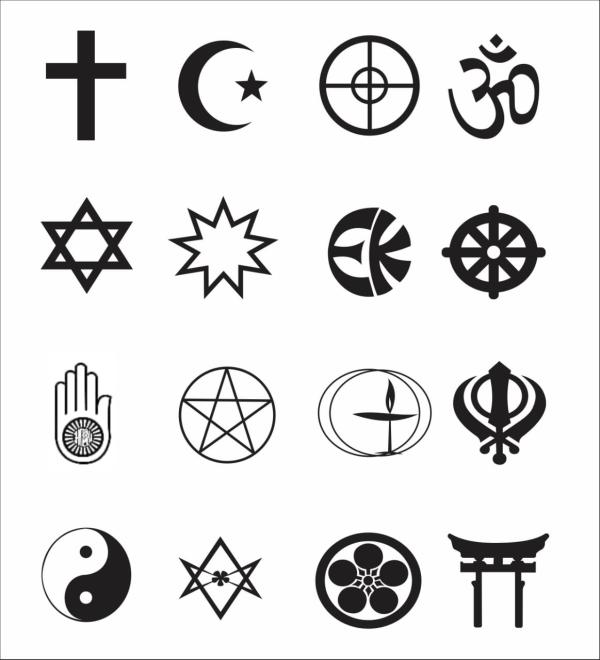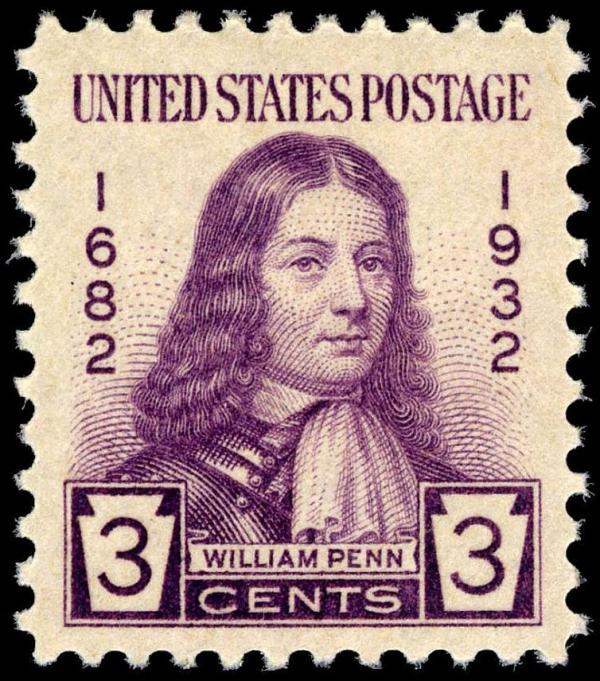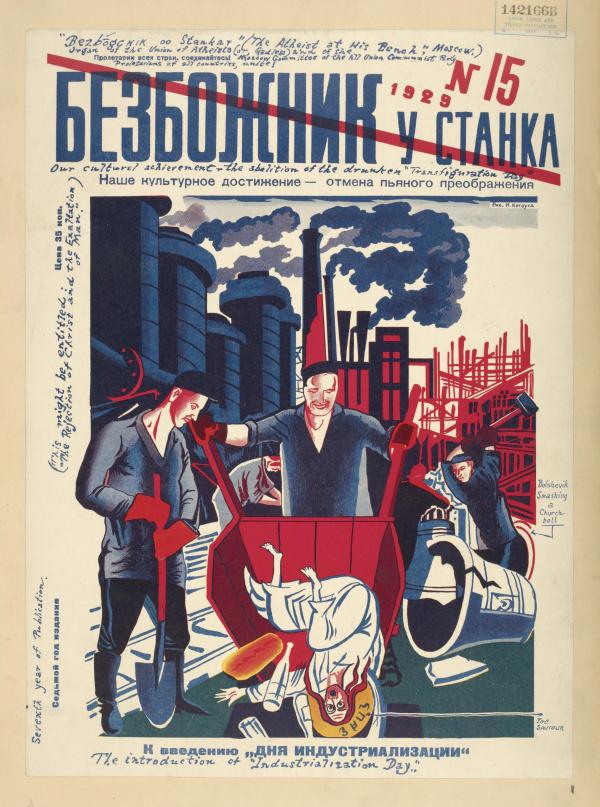Essential Principles
For most of world history, religion, like governance, was considered an absolute. Differences in religious beliefs within and among states and empires were the cause of revolts, wars, crusades, conquests, persecution, forced expulsion and attempted annihilation of entire religious groups. Even today, religion remains a central factor in many of the world's political conflicts and the cause of much state, as well as non-state, persecution.
Religious tolerance also has a long history. But the essential principle of freedom of religion and of conscience — including not to believe in any religion — developed as a principle of governance in the modern period.
The Roots of the Principle

Religious freedom is rooted in the plurality of beliefs around the world. Above, symbols representing from top left: Christianity, Islam, Onisese, Hinduism, Judaism, Baha'i, Ekankar, Buddhism, Jainism, Wiccanism, Unitarian Universalism, Sikhism, Taoism, Thelema, Tenrikyo, and Shinto. Creative Commons. Assembled by: Isèse Assembly.
Religious freedom is rooted in the plurality of religious and spiritual beliefs and practices throughout the world. Nearly all societies endeavored to explain the existence of the physical world and human existence through spiritual or religious means. Standards for how individuals should behave and how societies function were then often established according to a religious doctrine and practice. Initially, societies adopted folk or home-grown religions, mostly with polytheistic beliefs. Later, Christianity and Islam, monotheistic religions that emerged from the Abrahamic or Jewish tradition, became more dominant through conversion and conquest (see History).
States and empires generally fused governance with religion, the latter often serving as justification for autocratic rule. The most basic principle of religious freedom is state tolerance to practice different beliefs or faiths. There are many historical examples of such religious tolerance, from the Cylinder of Cyrus to the early Caliphates’ adoption of dhimmi (protected status for “persons of the book,” meaning Jews and Christians).
More commonly, however, the fusion of state and religion resulted in intolerance, namely state persecution and discrimination of faiths different than the officially adopted religion. Such intolerance included forcible expulsions of religious minorities, since rejection of the state’s adopted religion was seen as opposing the ruler’s authority (see History).
The most basic principle of religious freedom is state tolerance to practice different beliefs or faiths. There are many historical examples of such religious tolerance.
The fusion of state and religion often resulted in armed conflict between and among states with different official religions. Among these were the Wars of Religion in Europe in the 16th and 17th centuries between Catholic empires and states and principalities adopting Protestantism. To finally end these wars, the Peace of Westphalia signed in 1648 affirmed a first basic principle of religious freedom in international law: cuius regio, eius religio (“whose region, his religion”). This meant that religion would no longer be a casus belli or cause of war, which it had been for centuries. The treaty brought an enduring period of religious peace among European states even if other causes of war remained.
This principle, however, did not address differences in religious practice within states. Repression of non-official religions continued. As nation states developed, Enlightenment thinkers advocated for a new rationalist conception of natural rights as the basis for governance (see also Consent of the Governed). In this new intellectual framework, broader principles of religious freedom were adopted. Thus, the state should not coerce belief. Everyone must have freedom to practice any religion or no religion. And there should not be discrimination in public or private life based on religious belief.
[B]roader principles of religious freedom were adopted. . . . [T]he state should not coerce belief. Everyone must have freedom to practice any religion or no religion. And there should not be discrimination in public or private life based on religious belief.
These principles were embedded as early as William Penn’s Framework of Government for Pennsylvania in 1682. Thomas Jefferson embedded them a century later in another major framework for religious freedom, the Virginia Statute for Establishing Religious Freedom (see quote above). The Pennsylvania Framework of Government and the Virginia Statute established a broader principle in the United States: disestablishment of official religion from the state, also known by the phrase "separation of church and state." James Madison wrote this broad principle first into the US Constitution through a provision forbidding a religious test for public office. He then broadened the principle in the Constitution’s First Amendment (“Congress shall make no law respecting an establishment of religion, nor forbid the exercise thereof. . . ”).
In the United States, principles of religious freedom were necessary. The British colonies had developed as a refuge for different disfavored faiths. There could be no true self-governance in the new country without tolerance of others' beliefs. Preventing individuals from freely exercising their religious beliefs or practices could be done only through tyranny.
In turn, religious freedom required that religious groups have the right to govern themselves without state interference. Imposing state control over religious institutions in their functioning or appointments of clergy would also constitute tyranny (see History and US Country Study).
Tolerance and Tensions
Nearly all democracies today, even the few still with state established or favored religion (such as Denmark), guarantee freedom of religion and conscience in their constitutions and laws. Religious freedom is considered one of democracy’s essential principles. It is also embedded in international law, most importantly in the Universal Declaration of Human Rights (1948).
Nearly all democracies today, even the few still with state established or favored religion (such as Denmark), guarantee freedom of religion and conscience in their constitutions and laws.
Yet, even as religious freedom became a general norm in democracies from the 18th to 20th centuries, there remained state and societal discrimination based on religion. Protecting minorities against the majority’s intolerance required an additional principle: laws specifically barring religious discrimination in voting, employment, housing, education and other civil matters.
There are tensions within democracies over the meaning and practice of religious freedom. Two basic principles — separation of church and state and the freedom to worship without hindrance or discrimination — are sometimes seen to be in conflict. If a state is based on secular principles, should there be a ban on religious expression in state institutions? If the two basic principles have equal validity, should the state favor or disfavor religious institutions in taxation or education policies? When religious practices conflict with state laws, should the freedom to practice religion or the state’s laws prevail? May a democracy establish religious law as state law?

William Penn, commemorated in the stamp above, established the first constitutional basis for religious freedom through the Pennsylvania Framework of Government. Public Domain.
How these issues of religious freedom are balanced in democracies is often intertwined with issues of governance. A complex example illustrating the challenge is Turkey. Mustafa Kemal (also known as Atatürk) wrote a constitution in the mid-1920s establishing a secular state (in contrast to the Ottoman Empire, which existed formally as a religious caliphate). The constitution even empowered the military to assert emergency power to protect the state against religious extremism. It was also interpreted to limit customary religious practices (such as women wearing a hijab or headscarf when in government buildings). Over decades, Muslim believers chafed at state limitations, as well as the military exerting arbitrary power. An Islamist party defending religious practices was voted into power in 2002. That party and its leader ended many features of the secular state. In time, however, it adopted authoritarian practices against opposition secular parties to keep power (see also Turkey Country Study).
These tensions are ongoing. In France, laïcité (strict separation of church and state) was applied to ban wearing the hijab, or head scarf, in government offices and public schools (along with crosses and kippahs). The European Court for Human Rights ruled that law violated the guarantee of religious freedom. In the United States, recent Supreme Court rulings reversed long-standing precedents regarding establishment of religion as many devout believers exert power through elections (see also US Country Study in this section).
There are tensions within democracies over the meaning and practice of religious freedom. Two basic principles — separation of church and state and the freedom to worship without hindrance or discrimination — are sometimes seen to be in conflict.
There is sometimes a conflict between essential principles. One example was the reaction to the publication by a Danish newspaper of cartoons depicting the Prophet Muhammad, which is forbidden by Islamic law. There were worldwide protests, some violent, and an economic boycott of Denmark by many Muslim-majority countries. While the Danish prime minister defended the right to free speech, the publication issued a formal apology to defuse the crisis. This and other attacks on free expression on grounds of religious exercise has resulted in a common practice of self-censorship to avoid violence and intimidation (see also "Cartoon Wars" in History section in Freedom of Expression).
Dictatorships, Theocracies and Non-State Actors
As seen throughout Democracy Web, the essential principle of dictatorships is to deny human rights and reject the basic elements of democracy — from consent of the governed to freedom of association. Just as prior monarchs and emperors found heterodoxy — the rejection of the accepted state religion — to be a threat to their authority, so too dictators in the 20th and 21st centuries have considered religious freedom to be anathema to their rule. Dictatorships either repressed religious groups and expression or established state controls on the functioning or governance of religious institutions.
The most extreme repression of religious freedom was seen in the rise of totalitarianism.
The most extreme repression of religious freedom was seen in the rise of totalitarianism. Nazi Germany, while not based on religious doctrine, was based on Adolf Hitler’s maniacal ideology of racial purity. The Nazi regime systematically repressed Judaism, identifying Jews as an “alien race.” As reflected in centuries of anti-Semitism, Jews were claimed to threaten the large German (“Aryan”) majority despite their small population. With much of Europe under Nazi occupation in 1941-42, Adolf Hitler ordered a “Final Solution”: extermination. Six million Jews — two-thirds of European Jewry — were systematically murdered. It was a crime so heinous it required a new term: genocide.
The Union of Soviet Socialist Republics initially suppressed religion generally as an “opiate of the masses” that served the oppressive interests of owners of property. Immediately after the Russian Revolution, the Red Army and Cheka, the secret police, carried out mass repression of Orthodox priests and lay believers. The 1936 Constitution of the USSR ostensibly guaranteed the right of religious freedom but not in practice. All communist regimes modeled on the USSR outlawed or disfavored religion and repressed religious clergy and believers (see also History and Country Study of Vietnam in this section).

The Soviet Union repressed religion and made atheism a state doctrine. Above, a 1929 issue of an antireligious magazine (The Godless at the Workbench) published by the Communist Party. It shows a worker dumping Jesus Christ from a wheelbarrow as a symbol for replacing Transfiguration Day with Industrialization Day. Public Domain.
A specific category of religious repression is found in Iran. After the Iranian Revolution in 1979, the country’s religious leaders instituted a constitution with a theocracy. It required governance by a Supreme Leader appointed by religious leaders and strict adherence to Islamic law as interpreted by the Supreme Leader and governing religious institutions. Defiance of religious law is considered an act against the state and is severely punished. Religion is the justification for secular authority and the basis for state authority itself. Saudi Arabia has similar rule. While the monarchy is not formally a theocracy, the constitution establishes the Quran as the basis of law. Islamic religious authorities oversee the judiciary. (See also Country Studies).
A new category of religious repression is by non-state actors seeking to impose a terrorizing vision of Islam on populations. The Islamic State’s brutal violence inflicted on Christians, Yazidis (adherents of an ancient monotheistic faith) and fellow Muslims in Syria and Iraq was among the most extreme examples of religious intolerance in recent decades. Until being defeated by a coalition of Kurdish, Iraqi and US troops, the Islamic State had extended its caliphate across large parts of Syria and Iraq. ISIL, al Qaeda and other terrorist groups have adherents in many other countries seeking to impose religious tyranny (see Country Study of Nigeria in this section).
Religious Freedom, Democracy and Civil Society
The examples of antidemocratic governments and ideology above illustrate the great need for freedom of religion and the basic separation — either formally or in practice — of state and religion.
Without such a separation, religious institutions are easily compromised to serve state authority or act themselves as repressive state instruments. Dictatorships, however, did not succeed to suppress religion altogether or even to fully coopt religious institutions to serve authoritarian purposes. Indeed, religious institutions acting independently were part of many recent movements for broader political freedom, including those in Chile, Philippines, Poland and South Africa. Even in Nazi Germany and the USSR, individuals practiced religious beliefs and expressed themselves against the state, acting as dissidents against official authority.
The transformation of religion as justification for a state's authority and reason for war into a basis for democracy and individual freedom is one of the most important stories of modern history. That story is still unfolding.
Just as freedom of religion is a threat to the ruling authority of dictatorship, it is also an important safeguard within democratic society. Democracy requires a diversity of views and choices and an atmosphere of tolerance in which differing opinions can be debated civilly. Such an atmosphere is impossible without respect for freedom of conscience and worship. As importantly, religious institutions are a form of freedom of association. They organize civil society in the form of charitable, humanitarian and other social initiatives and groups that give citizens a means to organize outside the state.
The transformation of religion as justification for a state's authority and reason for war into a basis for democracy and individual freedom is one of the most important stories of modern history. That story is still unfolding.
The content on this page was last updated on .